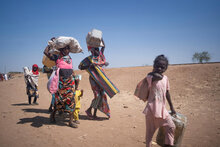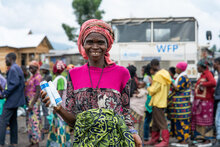In The Sahel Region Of Chad, Half The Population Faces Hunger
An Emergency Food Security Assessment conducted by the Government of Chad in partnership with WFP and other partners in the eight regions of the Sahelian belt, shows the food insecurity and malnutrition situation has worsened over the past year (compared to assessment results from March 2015).
“For vulnerable families throughout the Sahelian belt, the lean season this year will be extremely difficult. WFP is working with the Government and other partners to help the people of Chad to mitigate the impact of the crisis,”said Mary-Ellen McGroarty, WFP Country Director in Chad.
Over the past year, food insecurity rates have been steadily rising from 46 percent to 58 percent in the Kanem region, and from 40 percent to 49 percent in the Bahr el Ghazel region.
Malnutrition rates have also worsened since November 2015 in six out of the eight regions (Bahr El Ghazel, Batha, Kanem,Lac, Sila and Wadi Fira).
According to the assessment, various factors are contributing to the worsening food security and nutrition situation:
• erratic rainfall during the 2015/2016 growing season has led to 11 percent less food being produced compared to the previous year;
• insecurity and violence spilling across the border from neighbouring Nigeria due to Boko Haram has led to borders being closed and disrupted trade
• a rise in the price of cereal (for example, sorghum prices in Kanem region have risen by 19 percent and in Wadi Fira by 44 percent);
• a drop in livestock price due to disruptions in the cross border trading that has negatively impacted the pastoralist communities.
To limit the impact of a multifaceted crisis – food insecurity, economic difficulties, climate change –WFP and its partners are working to reach those who are the most vulnerable in the Sahelian belt.
Food assistance will be provided throughout the lean season (June to September) combined with specialized nutritional support for children, pregnant women and nursing mothers suffering from malnutrition. Lean season interventions will be followed by projects intended to mitigate the impact of shocks over the longer-term (for example by water harvesting and management systems being put in place).
The Emergency Food Security Assessment was conducted with 4,821 households with 10,226 children under five. It was conducted during March-April in the regions of Lac, Bahr el Ghazel, Kanem, Batha, Wadi Fira, Sila, Guéra, Ouaddaï in the Sahelian belt.
# # #
WFP is the world's largest humanitarian agency fighting hunger worldwide, delivering food in emergencies and working with communities to build resilience. Each year, WFP assists some 80 million people in around 80 countries.
Follow us on Twitter: @WFP_WAfrica; @wfp_media
The full EFSA report (in French) is available here.
For more information please contact (email address: firstname.lastname@wfp.org):
Nathalie Magnien, WFP/Tchad, Mobile +235 66 99 30 40
Adel Sarkozi, WFP/Dakar, Mobile +221 776375964


